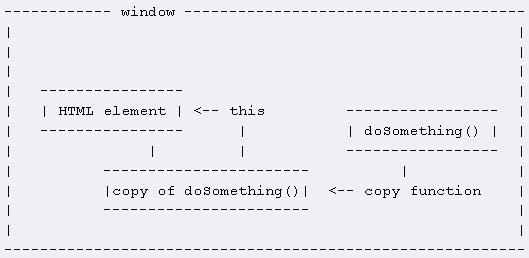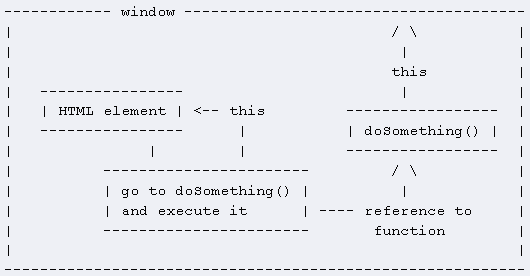Heim >Web-Frontend >js-Tutorial >javascript this用法小结_javascript技巧
javascript this用法小结_javascript技巧
- WBOYWBOYWBOYWBOYWBOYWBOYWBOYWBOYWBOYWBOYWBOYWBOYWBOriginal
- 2016-05-16 18:57:28998Durchsuche
this是面向对象语言中的一个重要概念,在JAVA,C#等大型语言中,this固定指向运行时的当前对象。但是在javascript中,由于 javascript的动态性(解释执行,当然也有简单的预编译过程),this的指向在运行时才确定。这个特性在给我们带来迷惑的同时也带来了编程上的 自由和灵活,结合apply(call)方法,可以使JS变得异常强大。
2.变化的this
在JavaScript中,this通常指向的是我们正在执行的函数本身,或者是指向该函数所属的对象(运行时)。当我们在页面中定义了函数 doSomething()的时候,它的owner是页面,或者是JavaScript中的window对象(或 global对象)。对于一个onclick属性,它为它所属的HTML元素所拥有,this应该指向该HTML元素。
2.1在几种常见场景中this的变化
函数示例
function doSomething ()
{
alert(this.navigator); //appCodeName
this.value = "I am from the Object constructor";
this.style.backgroundColor = "# 000000";
}
1. (A)作为普通函数直接调用时,this指向window对象.
2. (B)作为控件事件触发时
1) inline event registration 内联事件注册 .将事件直接写在HTML代码中(
2) Traditional event registration 传统事件注册 (DHTML方式).
形如 element.onclick = doSomething; 此时this指向 element对象
3)
3. (C)作为对象使用时this指向当前对象。形如:new doSomething();
4. (D)使用apply 或者call方法时,this指向所传递的对象。
形如:var obj={}; doSomething.apply(obj,new Array(”nothing”); //thisàobj
下面我来阐述如何在事件处理中来使用this,之后我会附加一些this相关的例子。
Owner
接下来文章中我们将要讨论的问题是:在函数doSomething()中this所指的是什么?
Javascript代码
function doSomething() {
this.style.color = '#cc0000';
}
function doSomething() {
this.style.color = '#cc0000';
}
在JavaScript中,this通常指向的是我们正在执行的函数本身(译者注:用owner代表this所指向的内容),或者是,指向该函数所属的对象。当我们在页面中定义了函数doSomething()的时候,它的owner是页面,或者是JavaScript中的window对象(或 global对象)。对于一个onclick属性,它为它所属的HTML元素所拥有,this应该指向该HTML元素。
这种“所有权”就是JavaScript中面向对象的一种方式。在Objects as associative arrays中可以查看一些更多的信息。 
如果我们在没有任何更多准备情况下执行doSomething(),this关键字会指向window,并且该函数试图改变window的 style.color。因为window并没有style对象,这个函数将非常不幸的运行失败,并产生JavaScript错误。
Copying
因此如果我们想充分利用this,我们不得不注意使用this的函数应该被正确的HTML元素所拥有。换句话说,我们应该复制这个函数到我们的onclick属性。Traditional event registration会关心它。
Javascript代码
element.onclick = doSomething;
element.onclick = doSomething;
这个函数被完整复制到onclick属性(现在成为了函数)。因此如果这个event handler被执行,this将指向HTML元素,并且该元素的颜色得以改变。 
这种方法使得我们能够复制这个函数到多个event handler。每次this都将指向正确的HTML元素: 
这样你就可以最大限度使用this。每当执行该函数,this所指向的HTML元素都正确响应事件,这些HTML元素拥有doSomething()的一个拷贝。
Referring
然而,如果你使用inline event registration(内联事件注册)
Javascript代码
你将不能拷贝该函数!反而这种差异是非常关键的。onclick属性并不包含实际的函数,仅仅是一个函数调用。
Javascript代码
doSomething();
doSomething();
因此,它将声明“转到doSomething()并且执行它”。当我们到达doSomething(),this关键字又重新指向了全局的window对象,函数返回错误信息。 
The difference
如果你想使用this来指向HTML元素响应的事件,你必须确保this关键字被写在onclick属性里。只有在这种情况下它才指向event handler所注册的HTML元素。
Javascript代码
element.onclick = doSomething;
alert(element.onclick)
element.onclick = doSomething;
alert(element.onclick)
你将得到
Javascript代码
function doSomething() {
this.style.color = '#cc0000';
}
function doSomething() {
this.style.color = '#cc0000';
}
正如你所见,this关键字被展现在onclick函数中,因此它指向HTML元素。
但是如果执行
Javascript代码
alert(element.onclick)
alert(element.onclick)
你将得到
Javascript代码
function onclick() {
doSomething()
}
function onclick() {
doSomething()
}
这仅仅是到doSomething()函数的一个引用。this关键字并没有出现在onclick函数中,因此它不指向HTML元素。
例子--拷贝
下面的例子中,this被写入onclick函数里:
Javascript代码
element.onclick = doSomething
element.addEventListener('click', doSomething, false)
element.onclick = function() {this.style.color = '#cc0000';}
element.onclick = doSomething
element.addEventListener('click', doSomething, false)
element.onclick = function() {this.style.color = '#cc0000';}
例子--引用
下述情况中,this指向window:
Javascript代码
element.onclick = function() {doSomething()}
element.attachEvent('onclick', doSomething)
element.onclick = function() {doSomething()}
element.attachEvent('onclick', doSomething)
注意attachEvent()的出现。Microsoft event registration model最主要的弊端是attachEvent()创建了一个指向函数的引用,而不是复制它。因此有时不可能知道哪个HTML正在处理该事件。
组合使用
当使用内联事件注册时,你可以将this发送到函数以至于可以正常使用:
Javascript代码
function doSomething(obj) {
//this出现在event handler中并被发送到函数
//obj指向HTML元素,因此可以这样:
obj.style.color = '#cc0000';
}
In Verbindung stehende Artikel
Mehr sehen- Eine eingehende Analyse der Bootstrap-Listengruppenkomponente
- Detaillierte Erläuterung des JavaScript-Funktions-Curryings
- Vollständiges Beispiel für die Generierung von JS-Passwörtern und die Erkennung der Stärke (mit Download des Demo-Quellcodes)
- Angularjs integriert WeChat UI (weui)
- Wie man mit JavaScript schnell zwischen traditionellem Chinesisch und vereinfachtem Chinesisch wechselt und wie Websites den Wechsel zwischen vereinfachtem und traditionellem Chinesisch unterstützen – Javascript-Kenntnisse

